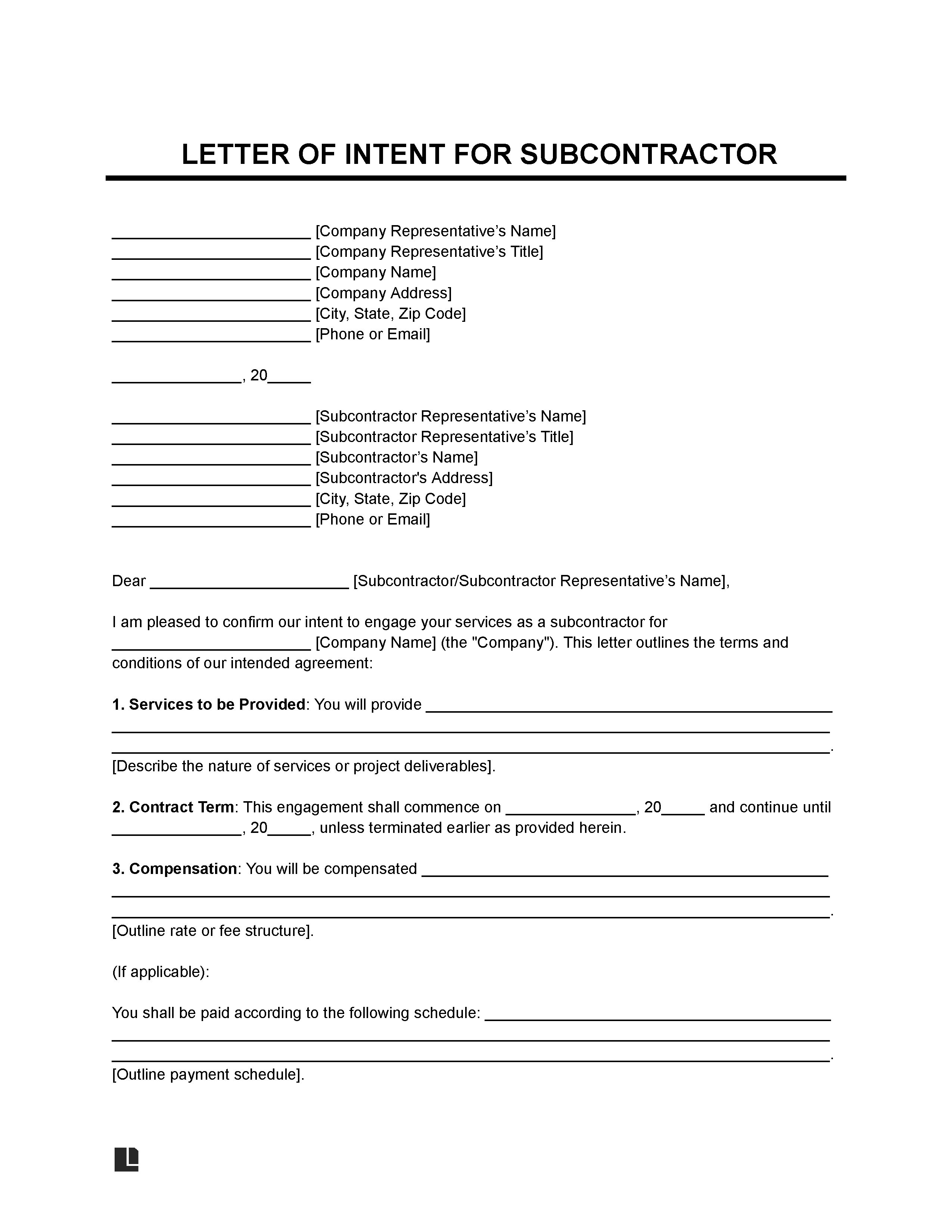A subcontractor letter of intent is used to express a subcontractor’s commitment to undertake work for a general contractor. This preliminary agreement outlines the scope of work, project specifics, timelines, and compensation details, serving as the foundation for a formal agreement.
Whether drafted by the subcontractor (an individual or business) or the prime contractor, this letter (LOI) often requests the contractor to initiate the work prior to the finalization of the formal contract.
How to Use
- Non-Binding Statement of Future Intentions: Often referred to as a “comfort letter,” this type of LOI serves as a non-binding declaration of both parties’ future intentions. It outlines their preliminary agreement without creating any legal obligations.
- Interim Contract: In some cases, the LOI acts as a temporary contract, setting the terms for the relationship between the parties until a written binding contract is finalized. This temporary agreement governs the work and responsibilities during the transition period.
- Final Contract: Occasionally, the LOI functions as the final contract. Even without formal execution, it incorporates the terms and conditions of the anticipated formal written contract, effectively binding both parties to those terms.
- Commonly Used With Subcontractor Agreement.
Key Components of a Subcontractor Letter of Intent
Parties Involved
Clearly state the names and addresses of both the contractor and the subcontractor. If either party is a company or organization, include the official name of the entity along with the contact details of a representative.
Scope of Work
Detail the specific services performed by the subcontractor as part of the project. This section should be thorough to prevent any future misunderstandings.
Location of Work
Provide the address of the primary location where the work will be performed. If the location is extensive or complex, include an exact description or specific areas where the subcontractor’s services are required.
Payment Details
Outline the subcontractor’s compensation, including whether they will be paid an hourly rate, a flat rate per job, or another payment structure. Also, specify the payment method and schedule, such as weekly, bi-weekly, or upon completion of milestones or the entire project.
Project Specifics
Include essential information such as the project name, a brief description of the work to be performed (construction work, roofing, plumbing, IT, etc.), and any relevant background information that contextualizes the subcontractor’s role.
Project Timeline
Highlight critical dates related to the project, including the start date, end date, and any significant milestones or deadlines, to ensure alignment on the project’s timeline and expectations.
Good Faith Negotiations
Include a clause committing both parties to negotiating in good faith. This means both parties agree to earnestly attempt to reach a final, binding agreement. Add the governing law for the LOI.
Confidentiality and Non-Disclosure
Include a section that specifies the subcontractor’s obligation to maintain confidentiality and avoid disclosing any proprietary or sensitive information acquired throughout the project duration, ensuring the protection of sensitive data.
Acceptance
Review the acceptance section thoroughly. Both parties must acknowledge the terms outlined in the LOI. To validate the agreement, include the subcontractor’s signature and date, followed by the printed name. Do the same for the contractor.
Tips for Drafting a Subcontractor Letter of Intent
What to Do
- Identify any issues that need resolution before the main subcontractor agreement is signed.
- Make it clear if the LOI is a temporary agreement pending the negotiation of the main contract, stating that neither party intends to be bound until the final contract is executed.
- Specify who will provide instructions related to the work carried out under the LOI.
- Explicitly mention which jurisdiction’s law will apply to the LOI.
- Incorporate a clear method for resolving disputes.
- Address whether the payment amounts include or exclude VAT.
- State that any payments made under the LOI will be treated as payments against the obligations under the main contract once this is concluded.
- Document any agreed-upon extensions to the LOI’s original expiry date in writing.
- Include provisions for what happens if the main contract is never agreed upon.
What to Avoid
- Replacing an LOI with a properly drafted contract.
- Including all terms of the main contract in the LOI.
- Exceeding the terms agreed upon in the LOI.
- Failing to send the other party a copy of the LOI for signature and return.
- Allowing the LOI to expire without formalizing the contractual relationship.
- Subcontractor’s Perspective: When the subcontractor initiates an LOI, they base it on project specifics provided by the contractor and preliminary discussions. The letter will outline the proposed work scope and terms from the subcontractor’s perspective.
- Contractor’s Approach: When drafted by the prime contractor, the LOI serves as a solicitation to multiple subcontractors for finding the right candidate. Each letter is tailored to a specific subcontractor, detailing project descriptions and compensation terms.
Subcontractor Letter of Intent Sample
Below, you can download a subcontractor letter of intent template in PDF and Word formats.


